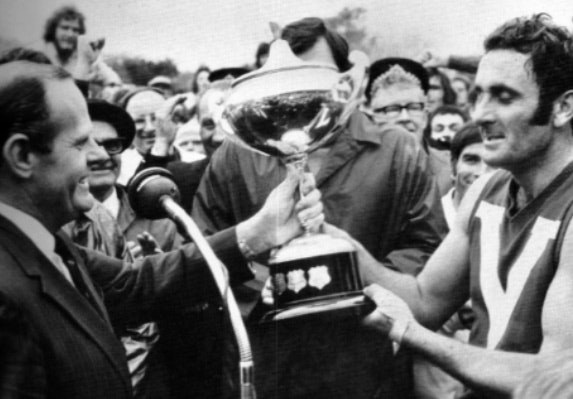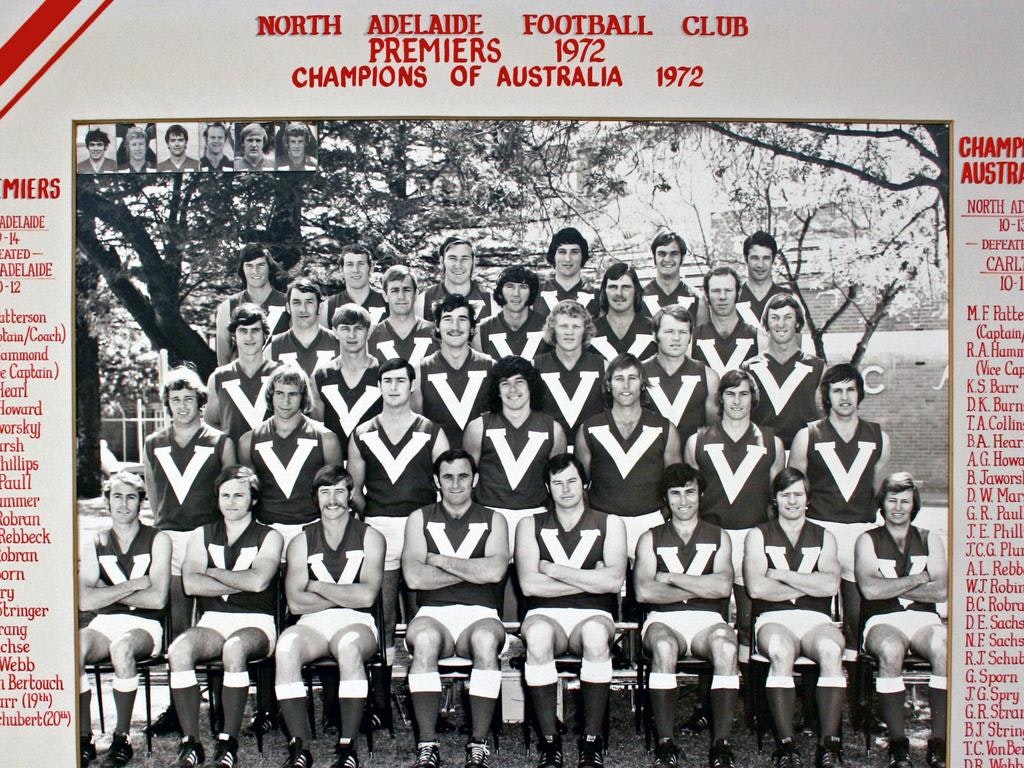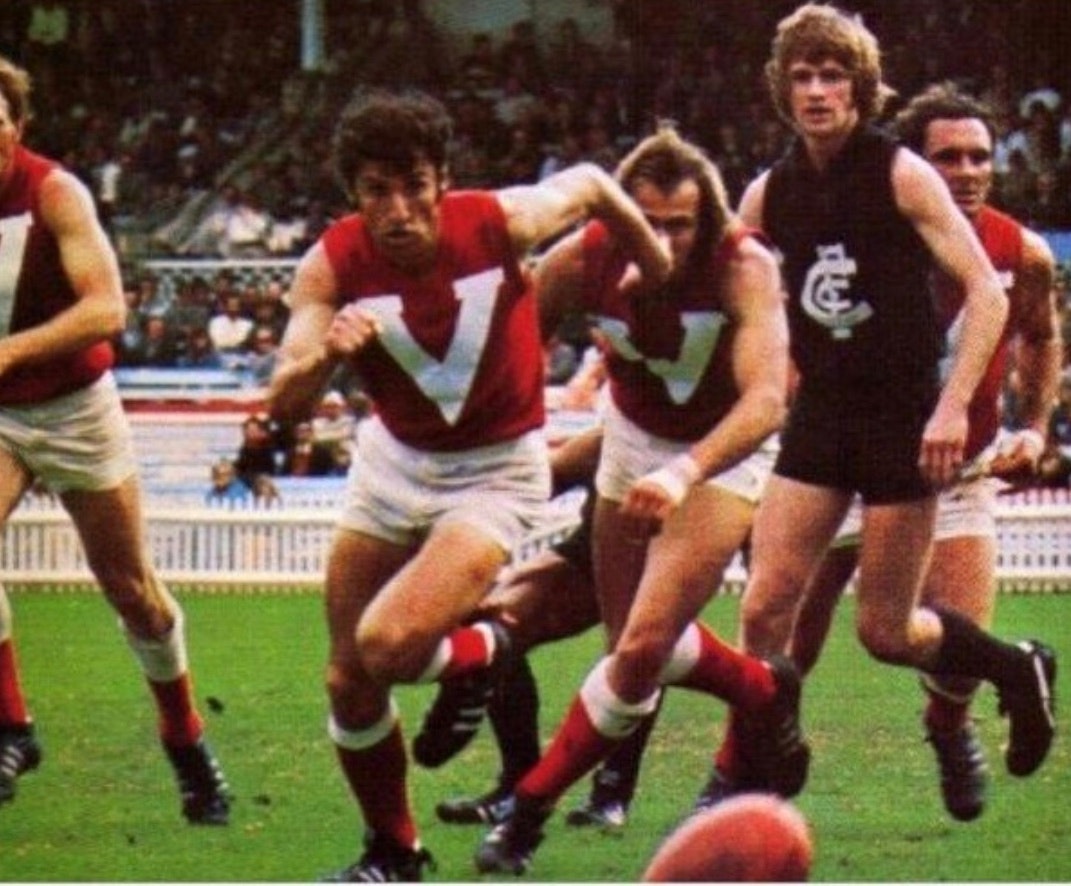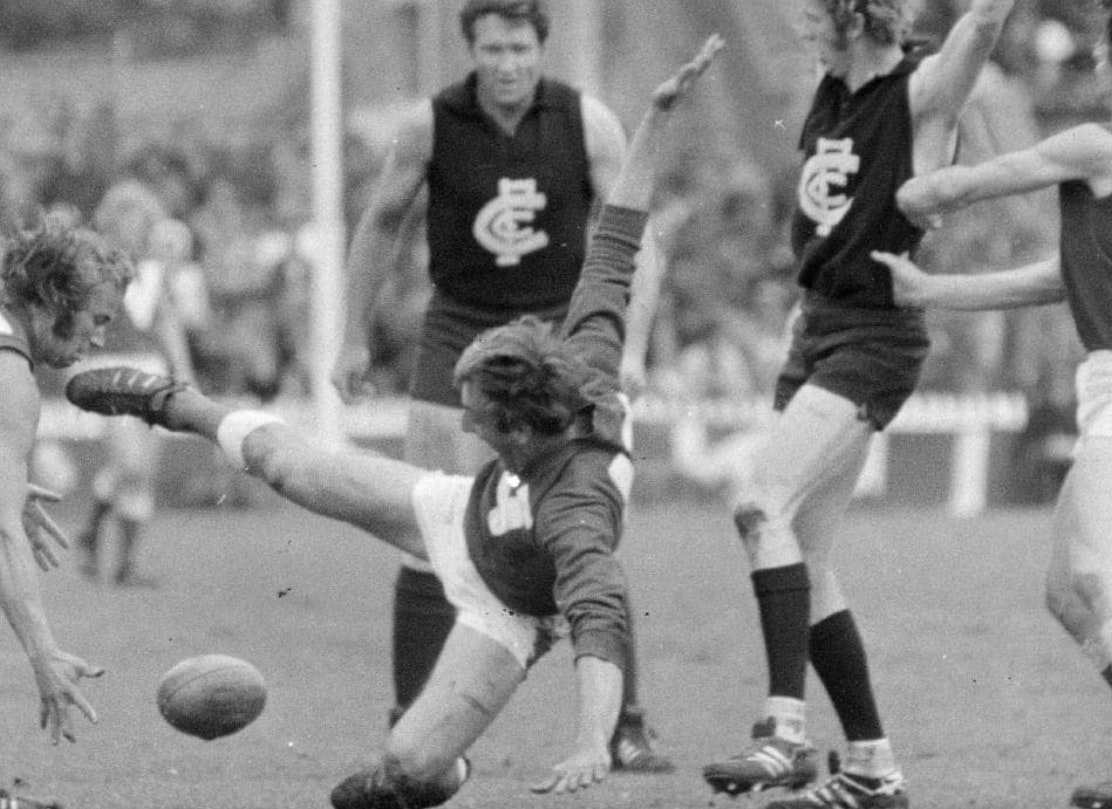
Celebrating North Adelaide’s 1972 ‘Champions of Australia’ triumph
Etched in history...North Adelaide captain Bob Hammond receiving the Champions of Australia trophy on October 15, 1972 after North Adelaide's memorable victory over Carlton.
This weekend (October 15) marks the 50th anniversary of SANFL Club North Adelaide’s triumphant win to become “Champions of Australia”, when the legend of Barrie Robran was enhanced by the applause of the legendary Alex Jesaulenko.
But do South Australians crow enough about one of the game’s greatest triumphs, writes SANFL History Centre contributor MICHELANGELO RUCCI.
In the “television era” – from the Baby Boomers of the 1960s to today – there are three moments that dominate the debate on South Australian football greatest achievements on the national stage:
- Fos Williams’ 1963 State team triumph against Victoria – the first South Australian triumph on the MCG in 37 years.
- Malcolm Blight’s Crows claiming back-to-back AFL flags in 1997-1998, at the MCG.
- Port Adelaide winning the first all non-Victorian AFL grand final at the MCG in 2004.
And the fourth perhaps falls through the cracks, lost in time – just like the black-and-white television footage of Carlton legend Alex Jesaulenko stopping in the middle of Adelaide Oval to applaud – and appreciate – the brilliance of future fellow Hall of Fame Legend, Barrie Robran…
BARRIE Robran did not see it…the North Adelaide great was running towards his team’s goal, leaving Carlton great Alex Jesaulenko flat footed on Adelaide Oval and applauding.
“Never saw it…still have not seen it,” says Robran, 50 years later of the moment that has become part of his legend.
With the exception of the 23,213 at Adelaide Oval that cold Sunday afternoon in October 1972, no-one else can recall seeing “Jezza” turn from rival to admirer of Robran’s sublime skills to evade a tackle. But so many speak of that episode, as if Jesaulenko’s claps still echo where the Cresswell Stand once stood at the southern end of Adelaide Oval.
Less than two minutes of the black-and-white television footage survive from the 1972 Champions of Australia final. It begins with Darryl Webb running into the open goal square at the River Torrens end to score the goal that puts North Adelaide in front by a point. It ends with Webb outmarking Bruce Doull on the SACA members’ wing and mistiming his torpedo kick against the wind. The ball falls out of bounds on the full while the Oval’s siren overrides the echo of veteran Victorian television commentator Mike Williamson, declaring: “Oh, what a boilover this is”.
North Adelaide, the back-to-back SANFL premiers, defeated Carlton, the VFL titleholder, for the 1972 Champions of Australia title on October 15.
For the first time since 1914 – when the Port Adelaide “Invincibles” beat Carlton at Adelaide Oval – a South Australian team could claim to be the best club in Australian football.
“That’s an honour to be acknowledged as the best club in Australia,” says Robran, 50 years later. “And that is not just a credit to our club, North Adelaide; it also is a tribute to South Australia.”
Yet beyond the story of Jesaulenko’s applause of Robran, very little is noted of North Adelaide’s significant triumph when South Australian football looks for its moments of pride during the so-called “post-war era”. There is the 1963 State team defying the Big V at the MCG in 1963, South Australia’s first win on the cradle of Australian football since 1926.
There are the back-to-back triumphs by Adelaide in the 1997 and 1998 AFL grand finals at the MCG, along with Port Adelaide’s national title – in the first non-Victorian AFL grand final – in 2004, also at the MCG.
But North Adelaide’s success – after Jack Oatey’s great Sturt teams lost the 1968, 1969 and 1970 Champions of Australian finals – falls into the cracks to be lost in time…like the remnants of the television film that has eluded so many, particularly the devoted souls in North Adelaide’s history group.
To Robran, the three-time Magarey Medallist and universally recognised as South Australia’s greatest player, that gloomy afternoon at Adelaide Oval shines in a career of 201 league games (a count shortened by the knee injury suffered in the State game against Victoria at the SCG in 1974).
“My greatest memory,” says Robran, “is my first match with North Adelaide (in 1967) because that is something I always wanted; wanted so badly as a boy growing up in Whyalla supporting North Adelaide. But don’t think this game (against Carlton) pales into insignificance.”
And yet the memories of the day the Roosters crowed – well before crowing took on a new definition in South Australian football – have fallen into the cracks of time.
“It was not recognised (appropriately) at the time – and not since,” says Robran. “People just sweep over what happened that day.”
Is this by perception that the VFL premier came to town for an end-of-season trip? It was not a serious title?
If this was the case – as perhaps might have been said of the original Champions of Australia series before World War I – the response from the Carlton hierarchy in defeat would suggest otherwise. Carlton secretary, 1947 Brownlow Medallist Bert Deacon, made it known in his club’s annual report that VFL teams would boycott (and sink) the series unless reworked to take into account the “tortuous” demands placed on his players.
And this was no makeshift Carlton unit sent to Adelaide along with WAFL premier East Perth and Tasmanian champion City South. Carlton had loaded up its squad as part of a “world tour” that was supposed to present Australian football to London, Athens and Moscow (which became Singapore).

THE BUILD-UP
North Adelaide won back-to-back flags for the first time in the club’s history. After claiming the minor premiership with a 16-5 win-loss record, while Robran and Port Adelaide sensation Russell Ebert were lined up against each other at Prospect Oval for the duel of the home-and-away series, North Adelaide took the direct path to the grand final at Adelaide Oval. It beat Port Adelaide by 21 points in the second semi-final and reinforced the superiority with a dominant second half for a 56-point win in the grand final on September 30.
“We celebrated across the weekend…and went to work on Monday,” recalls Robran. “We all had jobs to go to.”
It was a different story – and a significant twist – with Carlton in the VFL competition.
Carlton also won the minor premiership with an 18-1-3 win-draw-loss record. And the VFL finals series – and the Champions of Australia play-offs – were sent into a tilt by Carlton and Richmond playing a draw in their second semi-final at the MCG on September 16. Carlton lost the replay by 41 points seven days later, defeated St Kilda by 16 points in the preliminary final and defied Richmond coach Tom Hafey’s warnings of a belting in the grand final by scoring a 27-point win on October 7 (while the North Adelaide players rested in Adelaide).
The 16th Champions of Australia series – that began in 1888 with Norwood beating South Melbourne in a three-game series at Kensington Oval – opened on Saturday, October 14 with North Adelaide making its second appearance in the competition. Carlton was there for the sixth time (after playing in the 1907, 1908, 1914 series against Norwood, West Adelaide and Port Adelaide and winning the 1968 and 1970 titles against Sturt). East Perth and City South were at their first Champions of Australia titles.
“We had lost to Hawthorn (in the final) the year before,” Robran said. “It was a good match, even if the final score suggests otherwise. There was a goal in it with seven to eight minutes to go…and then Hawthorn went on a roll. But it was a good match.”
No-one could question North Adelaide’s intent. The man calling the shots at Prospect did not play “friendlies”.
Robran says Mike Patterson, the “Swamp Fox” who coached North Adelaide in 176 SANFL league games from 1970-1977, arrived at Prospect with everything expected of a Richmond premiership ruckman who played 152 VFL games from 1959-1969.
“He brought to our club a bit of hardness,” Robran said. “We lacked that hardness before ‘Patto’ came to North Adelaide. His presence as a player and his emphasis as a coach made us become a bit harder as a side,” Robran says.
“Mike also was very intense. He always played to win – win everything. And we wanted to win this series very badly. Don’t let anyone say we didn’t want this one.”

Pictured during the 1972 Champions of Australia final are Geoff Paull, Alan Howard, Trevor Keogh and Bob Hammond.
THE SERIES
North Adelaide opened with an easy win against City-South, almost doubling the score of the Tasmanian State champion – 143-74.
Carlton had a tougher day at the office. East Perth captain-coach Mal Brown, the noted firecracker of West Australian football, seemed on a personal mission to settle every score ever suffered by the Sandgropers at the hands of the Big V while the semi-final against Carlton turned into a bruising encounter. Carlton won comfortably on the scoreboard (135-84) but with significant pain on Adelaide Oval. Bruce Doull, Ian Robertson, Percy Jones, Trevor Keogh and Geoff Southby (who needed to see a dentist to replace a tooth after the semi-final) all felt Brown’s wrath – a wrecking show that was excused by the tribunal after Brown claimed he was concussed and was reacting with shock on the football field.
The next day would be about pure football.
“Terrible day,” recalls Robran of the weather that came over Adelaide Oval that Sunday. “I certainly remember the conditions (that left the cricket square at Adelaide Oval as a black mud pit). Very windy. Cold. A very squally (southerly) wind. And rain that swept across the ground consistently. Yeah, a terrible day.”
The football was of the opposite theme.
Scores were level at the end of the first term – 3.5 each.
Carlton dominated the second quarter, by taking advantage of the southerly but not of the opportunities at the old scoreboard end where it put up 4.5 to lead by 16 points at half-time.
Patterson’s instructions to the North Adelaide players were basic and concise. Win the contest, slam the ball onto the boot and keep moving the ball forward.
“I can remember ‘Patto’ saying to our defenders, ‘If you are in trouble, kick long to Barry Stringer’s wing’,’ Robran said. “Barry Stringer was a better player than he gets credit for. Kick to his area and he would outmark almost everyone.”
After having second and last use of the win, North Adelaide was still behind at three quarter-time: 8.12 (60) to 9.11 (65).
Remarkably, North Adelaide held Carlton to 1.1 during the last term – and scoreless across the last 12 minutes – while scoring 2.1 to win by one point.
“And into a strong head wind too,” says Robran.
“We have tried so hard to find the film,” adds Robran of a match that does need to be seen again.

Carlton’s annoyance in becoming the first VFL premier to lose the Champions of Australia title since World War I was highlighted in Deacon’s remarks in the club’s annual report.
Carlton, he wrote, “would not be prepared to subject players to such a tortuous series again, a (VFL) grand final one Saturday, celebrations throughout the week and then two more grand final-type games on the following Saturday and Sunday”.
“This is asking too much,” Deacon added. “If this championship series is to continue then clubs must not be asked to play two games in two days. A week later, when players left on the Carlton-Orlando World Tour, a number were still bearing the marks of the injuries received in the game against East Perth. Even a wonderful trip overseas was not compensation for such treatment.”
The series did continue. It ended in 1975 when North Melbourne beat Norwood in the only Champions of Australia event played at Football Park at West Lakes … and then South Australia and the VFL went into a “cold war” on how a national competition should be formed. There were competing national night series, including the 1977 Ardath Cup in which Norwood beat East Perth for the NFL title. But Australian football was in a political zone that would take more than a decade to resolve with VFL expansion to Perth and Brisbane in 1987.
On October 28, at the National Wine Centre in Adelaide, the 13 Champions of Australia still living will gather to put together their own memories with the only vision to be that run Darryl Webb makes to the Torrens end of Adelaide Oval to kick the winning goal…and his match-ending kick out-of-bounds on the full. There will be the picture above of North Adelaide captain, the late Bob Hammond, collecting the Champions of Australia trophy and the $10,000 cheque.
And there is the ever-lasting story of Jesaulenko applauding Robran.
Today, Jesaulenko’s ailing health denies him the memory of the moment. His premiership team-mate Robert Walls, who kicked 3.2 in the final, recalls every Carlton player was moved by watching Robran that weekend in Adelaide.
“To a man,” Walls says, “as we asked ourselves, ‘Who of these players from the other teams could come to the VFL and make it?’ Everyone agreed, Barrie Robran.”
Robran never did cross the border. He was North Adelaide and only North Adelaide.
But Robran did join Carlton for its “world tour” (while North Adelaide ruled as kings of Australian football) as one of All-Stars who played on The Oval in London, on a cramped soccer pitch in Athens and in Singapore on the way home, after the match in Moscow was cancelled.
CHAMPIONS OF AUSTRALIA FINAL
Adelaide Oval, Sunday, October 15, 1972
North Adelaide 3.5 5.6 8.12 10.13 (73)
Carlton 3.5 7.10 9.11 10.12 (72)
BEST – North Adelaide: Robran, Sporn, A. Rebbeck, Stringer, N. Sachse, Webb. Carlton: Crane, Keogh, Nicholls, Jackson, O’Connell, Jones.
SCORERS – North Adelaide: A. Rebbeck 4.6, Plummer 2.0, D. Sachse 1.3, Webb 1.3, Marsh, Robran 1.0, Hearl, N. Sachse, von Bertouch 0.1. Carlton: Walls 3.2, Kennedy 2.1, Jackson, Warden 1.2, Crane 1.1, Keogh, Nicholls 1.0, Jesaulenko 0.1, rushed 0.2
UMPIRE: Bill Deller (VFL).
CROWD: 23,213 at Adelaide Oval.
SANFL CLUBS TO WIN CHAMPIONS OF AUSTRALIA TITLES: Port Adelaide (1890, 1910, 1913 and 1913), Norwood (1888 and 1907), West Adelaide (1908 and 1911) and North Adelaide (1972).
Related News
-
 Obituary
ObituaryVale Ian Day
-
 Milestone
MilestoneLee’s love for Roosters strengthens toward 100 games
-
 History
HistorySouth Australian Greats in Australian Football Hall of Fame
-
 Hostplus League
Hostplus LeagueNorth Adelaide part ways with Jacob Surjan
-
 Checkside Chats
Checkside ChatsCheckside Chats with Laela and Daniel Ebert
-
 Milestone
MilestoneMighty Mitch Harvey joins SANFL 200 club
-
 History
HistoryA tradition we love
-
 Obituary
ObituaryVale Jeff Potter








